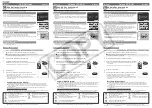
Appendix A
A-1
Appendix A: Glossary
This glossary lists some of the common terms encountered in IPDS printing over TCP/IP.
10base2.
A type of Ethernet that uses RG58 coaxial cable. Also called Thin Ethernet, ThinNet,
and CheaperNet.
10base5.
The original Ethernet standard that uses a thick coaxial cable. Also called thick
Ethernet or standard Ethernet.
10baseT.
A type of Ethernet that uses unshielded twisted pair cable.
100baseT4.
A 100 megabit/second networking standard based on Ethernet technology that
uses four pairs on a Category 3 twisted pair cable. Not widely used.
100baseTX.
The most popular 100 megabit/second networking standard based on Ethernet
technology. It uses two pairs on a Category 5 twisted pair cable.
802.2.
1. The IEEE standard for the Logical Link Control layer of the Ethernet protocol. The
LLC layer is implemented as special fields containing control information within an IEEE compati-
ble Ethernet frame. 2. The NetWare Ethernet frame type that includes both the IEEE 802.3 and
802.2 fields.
802.3.
1. The IEEE standard for Ethernet. 2. The default Ethernet frame type for NetWare
3.xx and 2.xx (also called 802.3 raw; the NetWare 802.3 is technically not IEEE com-
patible because it does not have the 802.2 fields).
802.11.
The IEEE standard for wireless Ethernet networks.
A4.
The international standard paper size (210 x 297mm).
Address.
An identifier. Every device on a network has a unique address.
AFP.
A
dvanced
F
unction
P
rinting. AFP is a worldwide standard for medium- to high-speed
electronic printing. AFP is a way to describe complex documents on IBM mainframe and mini-
computers, and the AFP format is converted to a print language by the operating system on the
computer. It creates a structured, high-performance print data stream that is system and printer
independent. AFP provides output flexibility, with support for view, fax, archive and desktop
print. Additionally, AFP printing utilizes Intelligent Printer Data Stream™ (IPDS™ ), which pro-
vides "industrial strength," system-managed printing even across the network.
















































